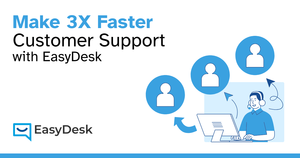Blog Information
- Posted By : Md Sheikh
- Posted On : Aug 31, 2025
- Views : 15
- Category : Technology
- Description : Learn how help desk software improves efficiency, customer satisfaction, and team productivity. Discover features, benefits, and best practices for businesses in 2025.
Overview
Help Desk Software: How to Transform Customer Support in 2025
Think about the last time you contacted a business with a problem. Were you put on hold forever? Did you get bounced from one department to another? Or did you receive fast, helpful support that left you impressed?
That last scenario doesn’t happen by accident. Behind the scenes, businesses that deliver consistently great service are usually powered by help desk software.
In today’s world, where customers expect instant responses and seamless experiences, this technology is no longer a “nice to have.” It’s essential.
What Exactly Is Help Desk Software?
At its core, help desk software is a tool that helps businesses manage and resolve customer issues efficiently. Instead of letting requests scatter across email, phone calls, social media, or live chat, the software centralizes them into a single system.
Each inquiry becomes a ticket, which can be tracked, assigned, and resolved—so nothing slips through the cracks.
Think of it as mission control for your customer support team.
Why Help Desk Software Matters More Than Ever
Customer expectations are rising every year. People want faster answers, smoother interactions, and personalized support. Businesses that fail to deliver risk losing customers to competitors who can.
Here’s how help desk software makes the difference:
-
Centralization – All customer communication in one place.
-
Speed – Automations route requests instantly.
-
Accountability – No ticket gets lost or ignored.
-
Insights – Reporting shows what’s working and where to improve.
Help Desk vs. Broader Customer Support Tools
It’s easy to confuse different support platforms. Let’s break it down:
-
Help desk software focuses on organizing and resolving issues through ticketing.
-
Customer service support software offers broader engagement features, such as chatbots, proactive messaging, and customer feedback systems.
Together, they create a complete support ecosystem. Help desk tools handle structure and resolution, while service platforms enhance customer engagement.
Key Features That Define Great Help Desk Software
When evaluating different platforms, here are the must-haves:
-
Omnichannel Support – Email, chat, phone, and social all feed into one inbox.
-
Automation – Auto-assign tickets, send updates, and escalate high-priority issues.
-
Knowledge Base Integration – Let customers help themselves through FAQs and guides.
-
Collaboration Tools – Notes, tagging, and shared visibility for team alignment.
-
Analytics & Reporting – Track response times, resolutions, and satisfaction scores.
These features don’t just make support easier—they make it smarter.
Small Teams, Big Impact
Many small and mid-sized businesses think help desk tools are “too advanced” or “too expensive.” The truth? They’re often the ones who gain the most.
With help desk software, a lean team can handle hundreds of inquiries without feeling overwhelmed. Automation does the heavy lifting, while structured workflows create a more professional impression.
When paired with customer support help desk software, smaller businesses can deliver support that rivals big enterprises.
How to Maximize the Value of Help Desk Software
Purchasing the software is just step one. To really benefit, you’ll need to use it strategically.
1. Personalize Responses
Automation is helpful, but customers still want a human touch.
2. Prioritize Issues
Not all tickets are equal—define workflows for urgent vs. routine cases.
3. Build a Self-Service Library
Keep FAQs, tutorials, and troubleshooting guides updated to reduce ticket volume.
4. Track the Right Metrics
Monitor first response times, resolution rates, and customer satisfaction regularly.
The Rise of AI in Help Desk Solutions
Artificial intelligence is becoming a game-changer in support systems. Modern help desks now include:
-
Chatbots for instant answers to common questions.
-
Sentiment analysis to detect unhappy customers early.
-
Predictive analytics to anticipate busy times.
Instead of replacing human agents, AI is giving them the power to focus on high-value conversations.
Future Trends to Watch
By 2025 and beyond, expect help desk software to evolve in exciting ways:
-
Proactive Support – Notifying customers of issues before they even ask.
-
Deeper Integrations – Tighter connections with CRMs, e-commerce, and collaboration apps.
-
Personalized Journeys – Tailored responses based on past interactions.
This isn’t just about efficiency—it’s about creating unforgettable customer experiences.
Final Thoughts
Customers want support that’s fast, reliable, and personal. Businesses that can deliver this consistently will earn not just sales, but loyalty.
That’s why help desk software is such a powerful tool. It keeps your support team organized, speeds up resolution times, and helps you build stronger customer relationships.
When combined with customer service support software and customer support help desk software, it creates a complete ecosystem for handling customer needs—today and in the future.
If you’re serious about improving customer experience in 2025, it’s time to make help desk software part of your business strategy.
-
